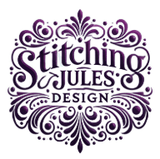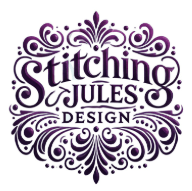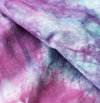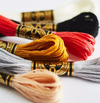There are several types of embroidery floss used in cross-stitch, each with unique properties that affect the look, feel, and difficulty of your project. Here's a breakdown of the different types of floss used in cross-stitch and how to use them effectively.
🧵 1. Cotton Floss (Most Common)
This is the most widely used type of floss for cross-stitch. It typically comes as a 6-strand divisible thread that can be separated based on the desired thickness of your stitches.
✅ Key Features:
- Material: 100% cotton
- Strands: 6 strands (you usually use 2 strands for cross-stitch on 14-count fabric)
- Finish: Soft, with a slight sheen
- Brands: DMC, Anchor, Sullivans, Cosmo
📌 Best For:
- Most cross-stitch projects
- Beginners and advanced stitchers
- Patterns with solid, bold colors
🧵 2. Variegated Floss
Variegated floss is dyed in gradual color changes along the length of the thread, creating a shaded or blended effect as you stitch.
✅ Key Features:
- Material: Cotton, silk, or synthetic
- Strands: 6 strands
- Color Changes: Subtle or dramatic, depending on the brand
- Brands: DMC, Weeks Dye Works, Gentle Arts
📌 Best For:
- Creating a hand-painted look
- Patterns that benefit from natural color variation (like landscapes, flowers, and sky scenes)
🧵 Tip:
To achieve smooth transitions, stitch one X at a time rather than working row by row.
🧵 3. Metallic Floss
Metallic floss is made of synthetic fibers mixed with metallic strands, giving it a shiny, sparkly appearance. It's often used for accents or special effects in patterns.
✅ Key Features:
- Material: Metallic fibers blended with polyester or cotton
- Strands: Usually 6 strands, but harder to separate
- Brands: DMC Light Effects, Kreinik, Anchor
📌 Best For:
- Holiday designs (like stars, ornaments, and snowflakes)
- Fantasy and magical patterns (like fairy wings or dragon scales)
⚠️ Challenges:
- Can be tricky to work with because it frays easily and tangles.
🧵 Tip:
Use shorter lengths to reduce tangling and try using thread conditioner (like Thread Heaven) to make stitching easier.
🧵 4. Silk Floss
Silk floss is made from natural silk fibers and is known for its luxurious texture and vibrant colors. It has a smooth, shiny finish that gives projects a more elegant appearance.
✅ Key Features:
- Material: 100% silk
- Strands: Typically 6 strands
- Finish: Extremely soft and shiny
- Brands: Au Ver à Soie, Gloriana, Classic Colorworks
📌 Best For:
- Heirloom projects or samplers
- Patterns that require rich, vibrant colors and a smooth finish
⚠️ Challenges:
- More expensive than cotton floss
- Can be slippery to work with
🧵 5. Rayon Floss (Viscose Floss)
Rayon floss is a synthetic alternative to silk. It’s shiny and smooth, but it can be difficult to work with because it’s very slippery and tangles easily.
✅ Key Features:
- Material: Rayon (viscose)
- Strands: Usually 6 strands
- Finish: High sheen (more shiny than cotton floss)
- Brands: DMC Satin, Anchor Artiste
📌 Best For:
- Projects that need a glossy, silky finish
- Patterns with elegant or decorative elements
⚠️ Challenges:
- Hard to control due to its slippery texture
- Prone to fraying and tangling
🧵 Tip:
Use shorter lengths and thread conditioner to manage tangling.
🧵 6. Hand-Dyed Floss
Hand-dyed floss is dyed in small batches, creating unique, variegated colors. Each skein can have subtle variations in color, making it ideal for samplers and vintage-style projects.
✅ Key Features:
- Material: Cotton, silk, or wool
- Strands: 6 strands
- Color Changes: More subtle and natural than machine-dyed variegated floss
- Brands: Weeks Dye Works, Gentle Arts, Classic Colorworks
📌 Best For:
- Rustic or antique-looking designs
- Samplers and primitive patterns
⚠️ Challenges:
- Colors may vary between dye lots, so buy enough floss for your entire project.
🧵 7. Wool Floss
Wool floss is made from natural wool fibers. It has a thicker texture and is often used in tapestry or needlepoint rather than traditional cross-stitch.
✅ Key Features:
- Material: Wool
- Strands: Usually thicker and not divisible
- Brands: Appleton Wool, DMC Médicis
📌 Best For:
- Tapestry and needlepoint projects
- Rustic or textured designs
⚠️ Challenges:
- Not suitable for fine cross-stitch designs
- Can be itchy to work with
🧵 8. Glow-in-the-Dark Floss
Glow-in-the-dark floss is a fun novelty floss that glows in the dark after being exposed to light.
✅ Key Features:
- Material: Synthetic fibers
- Strands: 6 strands
- Brands: DMC Light Effects (E940)
📌 Best For:
- Halloween patterns
- Stars, moons, and other glowing elements
⚠️ Challenges:
- Can be stiff and tricky to work with
- Doesn’t glow very brightly unless fully charged with light
🧵 9. Metallic Blending Filament
Blending filament is a very thin metallic thread used to add sparkle to standard cotton floss. It’s usually stitched alongside regular floss to create a shimmery effect.
✅ Key Features:
- Material: Metallic fibers
- Brands: Kreinik, DMC Light Effects
📌 Best For:
- Adding sparkle or shimmer to your project without using a full metallic floss.
⚠️ Challenges:
- Prone to tangling and breaking
- Must be used with another floss for full effect
🧵 Summary Table of Floss Types
| Type | Material | Best For | Challenges |
|---|---|---|---|
| Cotton Floss | 100% Cotton | Most cross-stitch projects | None (easy to work with) |
| Variegated Floss | Cotton/Silk | Shaded or blended effects | Must stitch one X at a time |
| Metallic Floss | Synthetic | Holiday designs, magical elements | Frays and tangles easily |
| Silk Floss | Natural Silk | Heirloom projects, luxurious finish | Expensive, slippery |
| Rayon Floss | Synthetic | Glossy, silky finish | Slippery, tangles easily |
| Hand-Dyed Floss | Cotton/Silk/Wool | Rustic or vintage designs | Colors vary between dye lots |
| Wool Floss | Natural Wool | Tapestry, needlepoint | Thick, not suitable for fine designs |
| Glow-in-the-Dark Floss | Synthetic | Halloween, stars, moons | Stiff, glow effect fades |
| Blending Filament | Metallic | Adding shimmer to designs | Must be used with regular floss |







